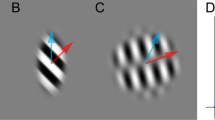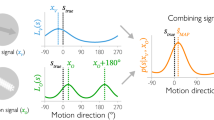Abstract
One of the more stunning examples of the resourcefulness of human vision is the ability to see ‘biological motion’, which was first shown1 with an adaptation of earlier cinematic work2: illumination of only the joints of a walking person is enough to convey a vivid, compelling impression of human animation, although the percept collapses to a jumble of meaningless lights when the walker stands still. The information is sufficient to discriminate the sex and other details of the walker3,4, and can be interpreted by young infants5. Here we measure the ability of the visual system to integrate this type of motion information over space and time, and compare this capacity with that for viewing simple translational motion. Sensitivity to biological motion increases rapidly with the number of illuminated joints, far more rapidly than for simple motion. Furthermore, this information is summed over extended temporal intervals of up to 3 seconds (eight times longer than for simple motion). The steepness of the summation curves indicates that the mechanisms that analyse biological motion do not integrate linearly over space and time with constant efficiency, as may occur for other forms of complex motion6, but instead adapt to the nature of the stimulus.
This is a preview of subscription content, access via your institution
Access options
Subscribe to this journal
Receive 51 print issues and online access
$199.00 per year
only $3.90 per issue
Buy this article
- Purchase on Springer Link
- Instant access to full article PDF
Prices may be subject to local taxes which are calculated during checkout



Similar content being viewed by others
References
Johansson, G. Visual perception of biological motion and a model for its analysis. Percept. Psychoph. 14, 201–211 (1973).
Marey, E.-J. Le Mouvement (Masson, Paris, 1894).
Mather, G. & Murdoch, L. Gender discrimination in biological motion displays based on dynamic cues. Proc. R. Soc. Lond. B 259, 273–279 (1994).
Dittrich, W. H., Troscianko, T., Lea, S. & Morgan, D. Perception of emotion from dynamic point-light displays represented in dance. Perception 25, 727–738 (1996).
Fox, R. & McDaniel, C. The perception of biological motion by human infants. Science 218, 486–487 (1982).
Morrone, M. C., Burr, D. C. & Vaina, L. Two stages of visual processing for radial and circular motion. Nature 376, 507–509 (1995).
Cutting, J. Aprogram to generate synthetic walkers as dynamic point-light displays. Behav. Res. Methods Instrument 10, 91–94 (1978).
Watson, A. B. Probability summation over time. Vision Res. 19, 515–522 (1979).
Burr, D. C. Temporal summation over moving images by the human visual system. Proc. R. Soc. Lond. B 211, 321–339 (1981).
Green, D. M. & Swets, J. A. Signal Detection Theory and Psychophysics (Wiley, New York, 1966).
Maloney, R. K., Mitchison, G. J. & Barlow, H. B. Limit to the detection of Glass patterns in the presence of noise. J. Opt. Soc. Am. A 4, 2336–2341 (1987).
Wilson, H. R., Wilkinson, F. & Asaad, W. Concentric orientation summation in human form vision. Vision Res. 37, 2325–2330 (1997).
Lappin, J. S. & Bell, H. H. The detection of coherence in moving random-dot patterns. Vision Res. 16, 161–168 (1976).
Barlow, H. B. & Tripathy, S. P. Correspondence noise and signal pooling in the detection of coherent visual motion. J. Neurosci. 17, 7954–7966 (1997).
Burr, D. C., Morrone, M. C. & Vaina, L. Large receptive fields for optic flow direction in humans. Vision Res. 38, 1731–1743 (1998).
Cutting, J. E. Coding theory adapted to gait perception. J. Exp. Psychol. 7, 71–87 (1981).
Marr, D. & Vaina, L. Representation and recognition of the movements of shapes. Proc. R. Soc. Lond. B 214, 501–524 (1982).
Ullman, S. in Human and Machine Vision (eds Beck, J., Hope, B. & Rosenfeld, A.) 459–480 (Academic, New York, 1983).
Watson, A. B. & Pelli, D. G. QUEST: A Bayesian adaptive psychometric method. Percept. Psychophys 33, 113–120 (1983).
Mather, G., Radford, K. & West, S. Low-level visual processing of biological motion. Proc. R. Soc. Lond. B 249, 149–155 (1992).
Acknowledgements
We thank H. Barlow and J. Ross for useful discussions. P.N. was supported by a scholarship from the Scuola Normale Superiore, Pisa. Supported by MURST and EC BIOMED (VIPROM).
Author information
Authors and Affiliations
Corresponding author
Rights and permissions
About this article
Cite this article
Neri, P., Morrone, M. & Burr, D. Seeing biological motion. Nature 395, 894–896 (1998). https://doi.org/10.1038/27661
Received:
Accepted:
Issue Date:
DOI: https://doi.org/10.1038/27661
This article is cited by
-
Representational momentum of biological motion in full-body, point-light and single-dot displays
Scientific Reports (2023)
-
Anomalous Perception of Biological Motion in Autism: A Conceptual Review and Meta-Analysis
Scientific Reports (2020)
-
Perception and decision mechanisms involved in average estimation of spatiotemporal ensembles
Scientific Reports (2020)
-
Complex visual analysis of ecologically relevant signals in Siamese fighting fish
Animal Cognition (2020)
-
Biological motion perception in autism spectrum disorder: a meta-analysis
Molecular Autism (2019)
Comments
By submitting a comment you agree to abide by our Terms and Community Guidelines. If you find something abusive or that does not comply with our terms or guidelines please flag it as inappropriate.



